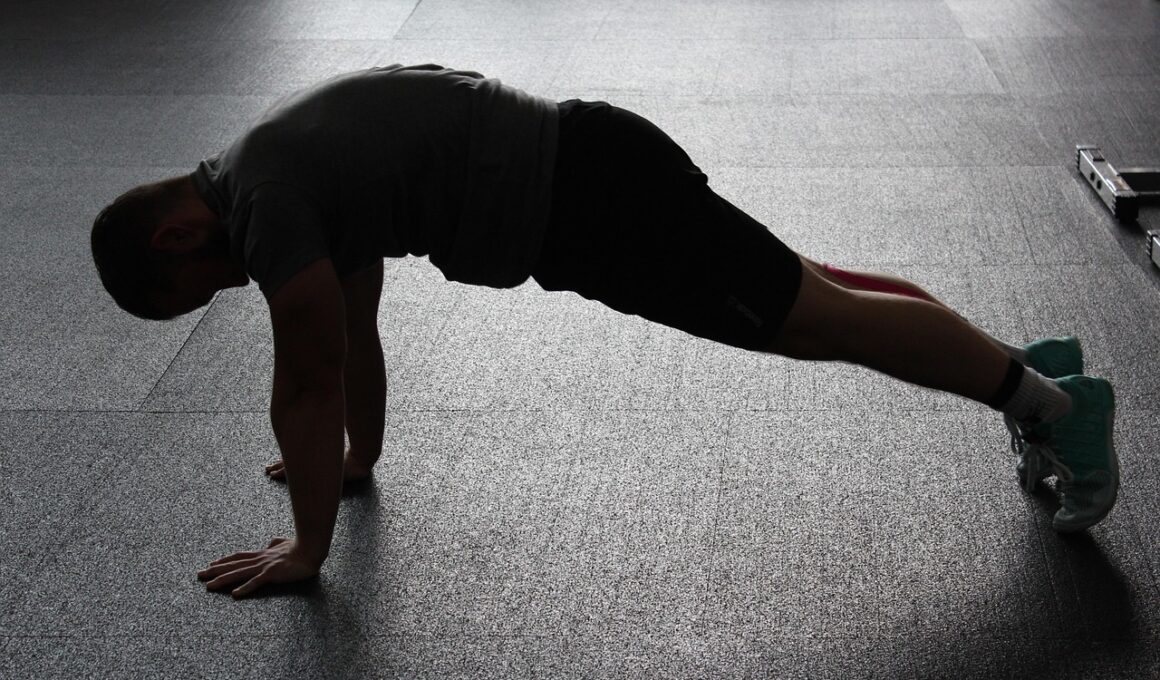CrossFit Warm-Up Routines for Enhancing Flexibility and Mobility
Warming up before engaging in CrossFit workouts is essential for enhancing muscle flexibility and mobility. A well-structured warm-up can prevent injuries and improve your overall performance. CrossFit’s dynamic nature requires various muscle groups to work effectively, so prioritizing an effective warm-up routine can set the foundation for a productive training session. Some successful warm-up techniques incorporate both mobility and flexibility exercises. Diverse movements stimulate blood flow and elevate your body temperature, adequately preparing your muscles and joints. One popular method involves performing a sequence of dynamic stretches such as leg swings, arm circles, and walking lunges to target multiple muscle groups. Regularly integrating these exercises into your routine will yield greater success in your performance, optimizing workouts and minimizing the risk of injury. Cool down after workouts is equally important to preserve your flexibility. After an intense session, engaging in static stretches can help maintain and improve your flexibility. This practice enhances recovery, allowing your body to rebuild strength and experience overall growth. Implementing these warm-up strategies not only benefits your physical readiness but also enhances your mental focus and readiness for the rigorous challenges ahead.
The Benefits of Mobility Exercises
Incorporating mobility exercises into your CrossFit warm-up is imperative for overall performance. Mobility exercises help improve joint flexibility, enabling better range of motion during workouts. As a result, athletes can achieve deeper squats, more explosive movements, and enhanced overall physical capabilities. Furthermore, mobility work targets muscle weaknesses and imbalances, leading to optimal movement efficiency. One efficient approach involves using resistance bands and foam rollers. These tools allow for self-myofascial release, which alleviates muscle tightness, increasing blood flow and muscle elasticity. Paying attention to specific muscle groups, such as the hips and shoulders, promotes better stability and alignment, crucial for executing complex movements in CrossFit. Adding elements such as dynamic hip openers, thoracic rotations, and ankle mobility drills can significantly enhance your workout experience. Consistent practice establishes functional stability, reducing injury risks during high-impact exercises. Also, it often translates into improved lifting capabilities, resulting in higher overall performance levels. Prioritizing mobility exercises during warm-ups not only directly benefits your exercise sessions but also contributes to increased overall flexibility, crucial for everyday movements outside the gym.
Effective CrossFit warm-up routines can be structured based on different workout types or focuses. For instance, you might adapt routines to emphasize strength, endurance, or Olympic lifting. Warm-ups should begin with light aerobic activity, such as jumping jacks, followed by dynamic stretches specific to the movements you plan to tackle. If you’re preparing for a weightlifting session, performing movements like front squats or deadlifts with lighter weights can develop good movement patterns while providing a dynamic warm-up. The key here is transitioning smoothly from one exercise to another while maintaining a steady heart rate. Increasing the intensity gradually will ignite your muscles, ensuring they are primed for the hard work ahead. You might find that working with a coach helps tailor your warm-ups according to your fitness level and goals. Engaging with your body and understanding how warm-ups affect your workout performance can contribute to effective overall routines. Also, consistently adapting these pre-workout rituals will help keep your muscles prepared and flexible, positively impacted by the well-designed warm-up protocols. Overall, effective warm-ups play an integral role in achieving your fitness aspirations.
Popular Warm-Up Exercises
A variety of popular warm-up exercises are extremely effective for CrossFit participants. Discovering which best suits your style will improve your transition into workouts. Mobility drills such as front-to-back leg swings are excellent for opening the hip flexors. Arm circles target the shoulders while promoting better range of motion. Adding bodyweight movements like air squats and push-ups will also engage multiple muscle groups simultaneously. Incorporating rotational movements prepares your core and spine for more complex exercises. Examples include trunk twists, which activate and warm up the back muscles effectively. As you increase mobility, consider integrating gait drills that develop coordination and agility. These drills mimic the patterns you’ll use during workouts, gradually increasing intensity to prepare your body thoroughly. Performing these movements over time enhances not only muscle readiness but also balance, coordination, and proprioception, which is vital during high-impact workouts. Don’t forget to incorporate some sport-specific movements as well; this will gear your body toward the specific demands required during the training session. Each warm-up should last anywhere from 10 to 15 minutes, depending on the intensity of the ensuing workout. Keep evolving your warm-ups for optimal performance gains.
Adopting breath control techniques during warm-ups can enhance the benefits significantly. Focusing on breathing patterns aids in relaxing your body, consequently activating the central nervous system. Controlled breathing will boost your focus and prepare you mentally and physically for the training ahead. Consider adding deep belly breathing exercises while performing stretches. This will allow your body to feel more engaged and increase blood flow during the warm-up process. Collaborating techniques like box breathing can also enhance overall focus and comfort. Through disciplined breath control, you empower yourself emotionally while mitigating anxiety or nerves often associated with high-intensity workouts. Avoid rushing through your warm-up; taking adequate time to connect with your body through breath and movement is crucial. Devoting time for mental preparation is as important as physical readiness in CrossFit training. By dedicating time to listen to your body and embrace mindfulness strategies, you’re much more likely to effortlessly transition into your workout routine. The connection will facilitate improved strength gains, physical endurance, and focus. Consistency in this practice will contribute significantly to your long-term fitness results, allowing you to push harder while staying injury-free.
The Role of Static Stretching
Static stretching plays a vital role in maintaining flexibility and mobility post-workout. Although it’s essential to warm up dynamically before workouts, static stretching serves as a cooling technique afterward. Engaging in gentle, sustained stretches targeting specific muscle groups helps to restore flexibility and prevent stiffness. The best time to incorporate static stretching is immediately after your workout when your muscles are still warm. This ensures deeper stretches and improves the benefits significantly. Effective static stretches for CrossFit enthusiasts include hamstring stretches, quadriceps stretches, and calf stretches. Incorporating these stretches into your routine will improve muscle elasticity and recover faster. This practice will ultimately enhance your performance in the long run. Additionally, dedicating time to reflect on recovery techniques will foster better mental preparation for future workouts. Improving flexibility helps you maintain optimal physical performance while increasing the range of motion needed for complex movements. Consistent dedication to these practices illustrates excellent self-care as an athlete, ultimately pushing you closer to your fitness goals. Finally, always listen to your body and understand the limit to avoid injury, ensuring a balanced approach to flexibility enhancement.
In summation, a structured CrossFit warm-up routine is indispensable for maximizing flexibility and mobility. With a combination of dynamic and static stretches, athletes can properly prepare for the challenges that lie ahead. In addition, integrating mobility exercises and breathing techniques promotes better performance, enhances overall readiness, and fosters a stronger connection with the body. Always aim to tailor your warm-ups according to the specific movements you will be performing. Consistency is key when it comes to witnessing improvements in flexibility and mobility, so make it an essential part of your regimen. Explore various warm-up styles, experiment with different exercises, and develop a routine that works for you. Furthermore, don’t forget to prioritize post-workout recovery by engaging in static stretches. This two-pronged approach promotes both safety during workouts and success in achieving your fitness goals. Remember that gradually increasing intensity and duration of flexibility workouts are crucial as you progress. Lastly, always remain mindful of your body’s signals to gauge your readiness adequately and adjust your routine accordingly. With dedication, a proper warm-up will pave the way for enhanced performance and lower the chances of injuries in CrossFit.
Always consider consulting with a coach or fitness professional for tailored guidance that meets your needs. Customizing your warm-up will help pave the way for a successful CrossFit experience. Engage with like-minded individuals to share various strategies. This offers insights into what works best in warm-up routines, allowing you to refine your practice effectively. Experimentation is essential in discovering which strategies yield the best results. Ultimately, the goal is to create an efficient warm-up routine that promotes injury prevention, enhances performance, and supports flexibility and mobility throughout your training journey. Implement these tips routinely for immediate benefits and long-term gains in CrossFit. Remember that consistency, progress tracking, and adjustment are the keys to achieving your Fitness aspirations. The flexibility and mobility you develop initially can enhance your workouts and significantly impact your everyday activities, making them smoother and more effortless. As you progress in your training, you will discover greater correlations between your warm-up practices and performance levels. Foster a culture of flexibility enhancement and mobility in your CrossFit training, sharing knowledge with others to improve collective results in achieving fitness excellence. Engage in respectful discussions about techniques and experiences to gain fresh perspectives.


